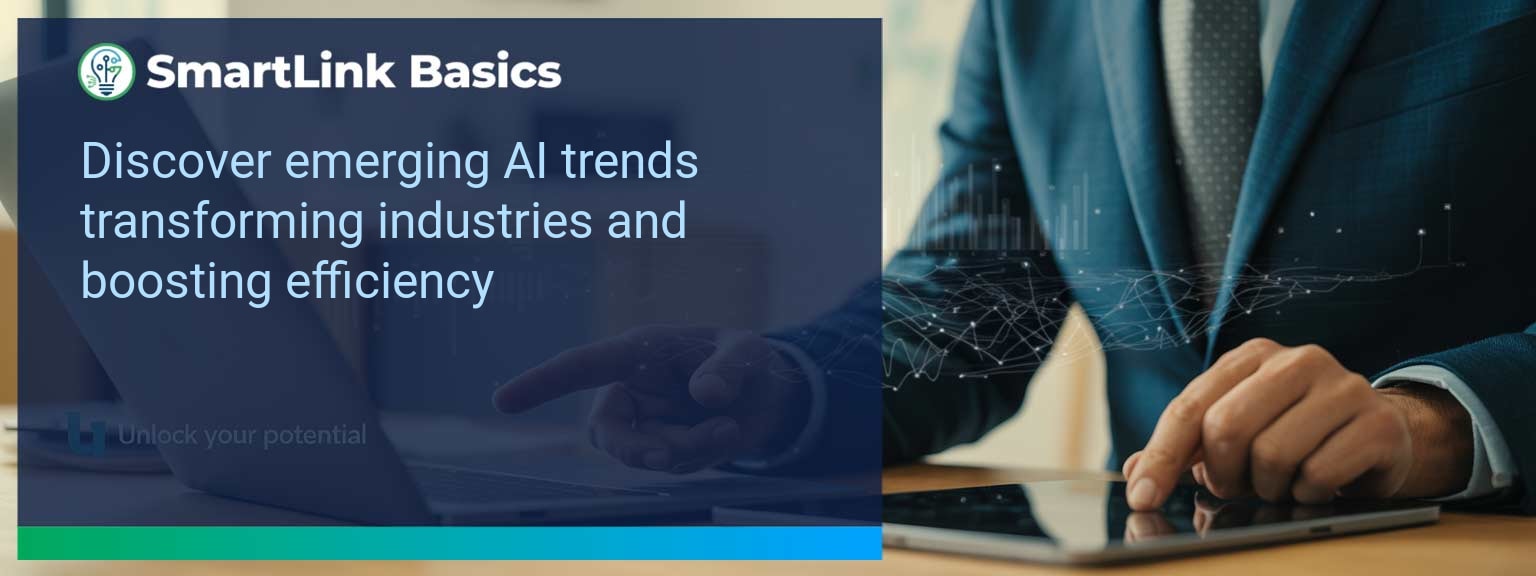Automation is entering a phase where AI-driven decision-making outpaces traditional human-led processes in speed, scale, and accuracy. According to PwC, AI could contribute up to $15.7 trillion to the global economy by 2030, yet many organizations have yet to operationalize these gains effectively. At SmartLink Basics, we see sales leaders facing the urgency to integrate AI automation not only to stay competitive but to redefine how value is created across their revenue systems. This article explores the emerging AI trends every decision-maker should track, the barriers to adoption, and the playbook to turn AI innovations into measurable business outcomes.
- AI adoption is accelerating revenue transformation across industries.
- Emerging AI trends center on predictive analytics, generative content, and autonomous workflows.
- Barriers to adoption include data readiness, integration costs, and change management.
- Innovation in AI automation delivers measurable gains in win rates and operational efficiency.
- Sales leaders who invest in adaptive AI frameworks are better positioned for market shifts.
What Changed and Why Emerging AI Trends Matter Now
Sales organizations have shifted from using AI as a peripheral tool to embedding it at the core of their operating model. This evolution is fueled by breakthroughs in machine learning trends such as real-time intent scoring, NLP-driven engagement, and automation in AI-powered qualification. These capabilities are compressing sales cycles and enhancing conversion predictability. One B2B SaaS company integrated AI-based lead scoring and saw a 22% increase in pipeline velocity in four months. The pattern is clear: leaders who harness these AI technology advancements early position themselves ahead on both revenue growth and cost efficiency. Begin with a clear inventory of customer data quality and system interoperability before deploying large-scale AI automation across sales workflows.Redesign the Revenue Operating System with Emerging AI Trends
AI innovations are not plug-and-play upgrades—they demand a redesign of your revenue operating model. ICP, Segmentation, and Targeting AI enables highly precise ideal customer profiles based on thousands of micro-signals. Instead of static segmentation, models adapt as market behaviors shift. Pipeline Architecture Machine learning forecasts probability-weighted revenue with greater accuracy, allowing resource allocation to the most promising deals. Plays and Messaging Generative AI creates contextually personalized messaging at scale. One manufacturing firm cut prospecting prep time by 70% using these models. Operating Cadence AI-powered alerts trigger timely follow-ups, aligning the team to buyer readiness rather than static schedules. Review each component quarterly to keep your AI-driven revenue system aligned with both customer expectations and internal efficiency goals.Identifying Key Barriers To Adoption
Even as the future of artificial intelligence becomes more attainable, adopting AI automation at scale faces structural resistance. Data readiness is a significant barrier—outdated systems limit model training potential. Integration costs can also delay implementation, especially without a clear ROI roadmap. For example, a financial services firm delayed deploying predictive analytics for 18 months due to fragmented CRM and compliance workflows. Without harmonized systems, AI outputs remain underutilized. Prioritize foundational data governance and phased integration to mitigate cost shocks while gradually preparing the organization for advanced automation in AI.Leveraging Innovation To Accelerate Growth
Emerging AI trends are enabling intelligent systems that enhance decision precision. Predictive forecasting, robotic process automation, and AI-driven coaching can each lift productivity when implemented with focus. A logistics company piloting AI-driven route optimization reduced fuel costs by 18% within 90 days. This quick win supported leadership buy-in for broader automation in AI applications. Identify initial use cases with clear KPIs and short feedback loops so momentum builds with measurable success.Positive Industry Impact And Measurable Outcomes
AI innovations are not only transforming internal sales processes but also creating ripple effects across supply chains, client onboarding, and market entry strategies. Organizations applying AI-driven enablement show consistent gains in both efficiency and accuracy. For instance, businesses that adopted intelligent contract analysis saw negotiation cycles shortened by 30%, improving customer experience and cash flow predictability. Adopt an outcome-first approach that tracks both revenue and process quality metrics to sustain gains from AI adoption.Predicting The Next Wave Of Change
The artificial intelligence future will extend beyond current automation into autonomous decision agents, contextual market sensing, and adaptive pricing engines. These shifts will redefine customer engagement and competitive positioning. Companies preparing now will already have cultural and operational readiness for leveraging advanced automation in AI tools when they mature. Use expert insights from SmartLink Basics to benchmark capabilities and prepare for the coming wave in AI-powered sales strategies.Metrics That Matter
| Category | Metric | Definition | Target |
|---|---|---|---|
| Leading | AI-Qualified Lead Ratio | Percentage of leads scored by AI meeting ICP criteria | ≥ 85% |
| Lagging | Pipeline Velocity | Revenue movement speed through the sales process | +20% YoY |
| Quality | Forecast Accuracy | Variance between AI-generated and actual closed revenue | ≤ 5% variance |
Get the 90-day plan, coaching rubric, and dashboard template to operationalize AI in your enablement program.









